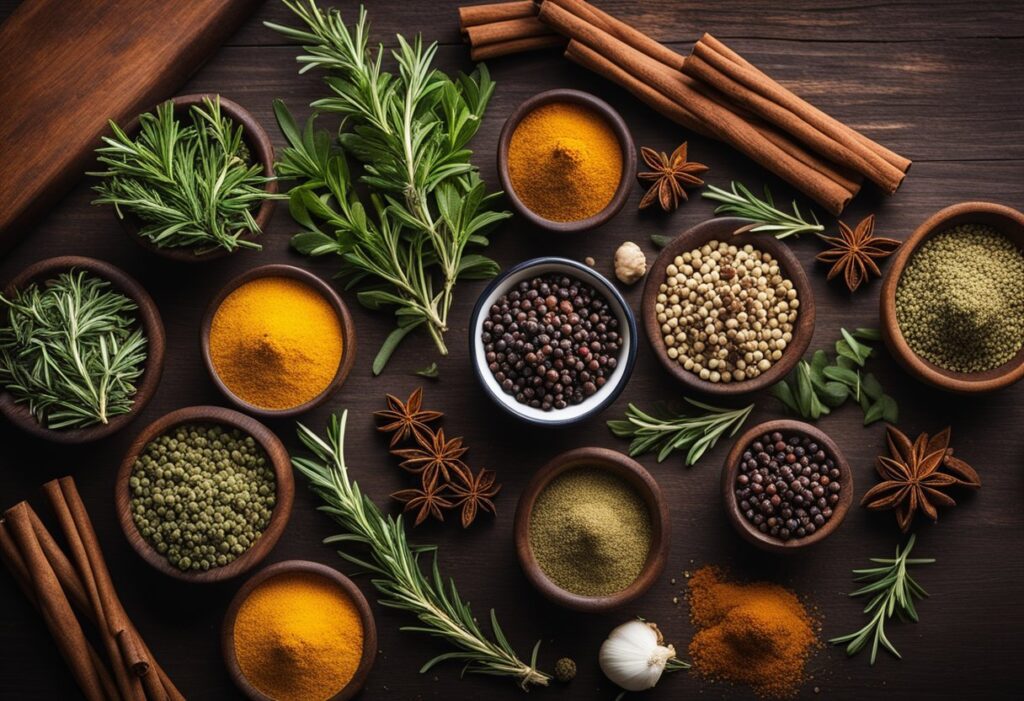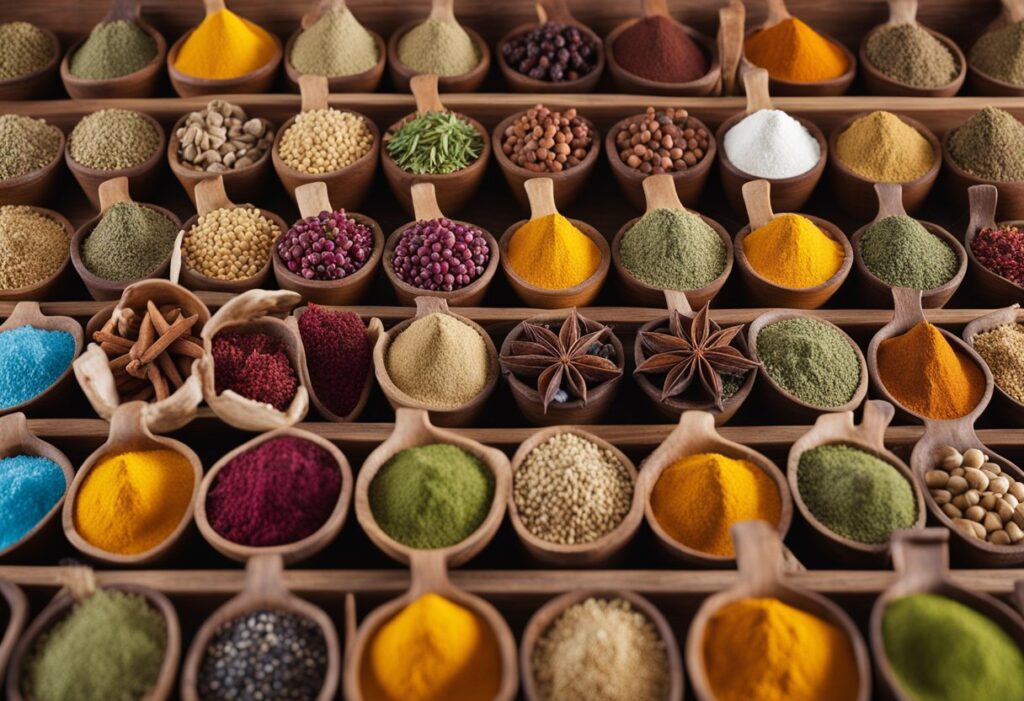Herbs and spices have been used for centuries to enhance the flavor and aroma of food. They are an essential part of culinary traditions around the world, and have been valued not only for their taste, but also for their medicinal properties. Herbs and spices come in a wide variety of flavors and aromas, ranging from sweet and floral to pungent and savory.

Herbs are the leaves, stems, and flowers of plants, while spices are typically derived from the seeds, bark, or roots of plants. Both are used to add flavor to food, but herbs are generally milder than spices. Some of the most common herbs used in cooking include basil, thyme, rosemary, and parsley, while popular spices include cinnamon, cumin, ginger, and turmeric.
In addition to adding flavor to food, herbs and spices have also been used for their health benefits. For example, ginger has been used to treat nausea and inflammation, while turmeric has been shown to have anti-inflammatory properties. As people become more interested in natural remedies and healthy eating, the use of herbs and spices is likely to continue to grow.
History of Herbs and Spices
Herbs and spices have been used for thousands of years for their culinary, medicinal, and aromatic properties. The history of herbs and spices dates back to ancient times, where they were highly valued and traded as commodities.
In ancient Egypt, herbs and spices were used for medicinal purposes, as well as for embalming and preserving the dead. Egyptians also used herbs and spices in their cooking, and they were often used in religious ceremonies.
The Greeks and Romans also used herbs and spices extensively, both for cooking and for medicinal purposes. Greek physician Hippocrates, known as the father of modern medicine, used herbs and spices to treat his patients.
During the Middle Ages, herbs and spices were used to mask the taste of spoiled food, which was common due to lack of refrigeration. They were also used to treat a variety of ailments, and many of the herbs and spices we use today were first cultivated during this time.
In the 15th and 16th centuries, European explorers brought back new herbs and spices from their travels to the Americas, Asia, and Africa. This led to the spice trade, where spices such as cinnamon, pepper, and nutmeg were highly valued and traded for large sums of money.
Today, herbs and spices are widely used in cooking and continue to be valued for their medicinal and aromatic properties. They are also used in the production of perfumes, cosmetics, and pharmaceuticals.
Types of Herbs
Culinary Herbs
Culinary herbs are the most commonly used herbs in cooking. They add flavor and aroma to dishes and are often used in small quantities. Some popular culinary herbs include basil, thyme, rosemary, oregano, and parsley. These herbs are usually added to dishes towards the end of cooking to preserve their flavor and aroma.
Medicinal Herbs
Medicinal herbs have been used for centuries to treat various ailments. They contain natural compounds that have therapeutic properties and are often used in alternative medicine. Some popular medicinal herbs include echinacea, ginger, chamomile, and ginseng. These herbs can be consumed as teas, tinctures, or supplements.
Aromatic Herbs
Aromatic herbs are known for their pleasant fragrance and are often used in perfumes, soaps, and candles. They can also be used in cooking to add flavor and aroma to dishes. Some popular aromatic herbs include lavender, mint, lemon balm, and sage. These herbs can be used fresh or dried and are often used to make herbal sachets or potpourri.
In summary, herbs are a versatile and essential ingredient in cooking, medicine, and aromatherapy. Knowing the different types of herbs and their uses can help you make the most of their benefits.
Types of Spices

Spices are an essential part of cooking and can add flavor, aroma, and color to any dish. There are different types of spices available, and each has its unique taste and properties. In this section, we will explore three main categories of spices: sweet, savory, and hot.
Sweet Spices
Sweet spices are those that add a touch of sweetness to the dish. They are often used in baking and desserts but can also be used in savory dishes. Some of the most popular sweet spices include:
- Cinnamon: Cinnamon is a versatile spice that can be used in sweet and savory dishes. It has a warm, sweet flavor and is often used in baking, hot drinks, and curries.
- Nutmeg: Nutmeg is a warm, sweet spice that is often used in desserts, such as pies and custards. It can also be used in savory dishes, such as soups and stews.
- Cardamom: Cardamom has a sweet, floral flavor and is often used in baking and desserts. It is also used in Indian and Middle Eastern cuisine.
Savory Spices
Savory spices are those that add depth and complexity to a dish. They are often used in meat dishes, soups, and stews. Some of the most popular savory spices include:
- Cumin: Cumin has a warm, earthy flavor and is often used in Mexican, Indian, and Middle Eastern cuisine. It is a key ingredient in chili powder and is often used in meat dishes.
- Paprika: Paprika is a sweet and smoky spice that is often used in Hungarian cuisine. It can also be used in meat dishes, stews, and soups.
- Thyme: Thyme has a subtle, earthy flavor and is often used in meat dishes, soups, and stews. It pairs well with other savory spices, such as rosemary and sage.
Hot Spices
Hot spices are those that add heat to a dish. They are often used in spicy dishes, such as curries and chili. Some of the most popular hot spices include:
- Chili powder: Chili powder is a blend of spices that includes cumin, paprika, and cayenne pepper. It is often used in Mexican and Tex-Mex cuisine.
- Cayenne pepper: Cayenne pepper is a hot spice that is often used in spicy dishes, such as curries and chili. It can also be used to add heat to soups and stews.
- Black pepper: Black pepper is a common spice that adds heat and flavor to a dish. It is often used in meat dishes and is a key ingredient in many spice blends.
In conclusion, spices are an essential part of cooking and can add flavor and depth to any dish. By understanding the different types of spices available, you can create delicious and flavorful meals that will impress your family and friends.
Cultivation and Harvesting
Growing Conditions
Herbs and spices can be grown in a variety of conditions, depending on the plant’s needs. Some prefer full sun, while others thrive in partial shade. Soil type and pH level are also important factors to consider when growing herbs and spices.
For example, basil prefers a well-draining soil with a pH range of 6.0-7.5. It is a heat-loving plant and needs full sun to grow. On the other hand, mint prefers partial shade and moist soil with a pH range of 6.0-7.0.
It is important to research the specific needs of each herb and spice before planting to ensure proper growth and yield.
Harvesting Techniques
The timing of the harvest is crucial when it comes to herbs and spices. Most herbs should be harvested before they flower, while spices are typically harvested when the fruit or seed is mature.
When harvesting herbs, it is best to pick the leaves in the morning after the dew has dried. This is when the essential oils are at their peak. To encourage bushy growth, pinch back the tips of the plant regularly.
Spices such as black pepper are harvested when the berries turn red. They are typically picked by hand and then dried in the sun. Once dry, the outer layer is removed to reveal the seed inside.
Overall, proper growing conditions and harvesting techniques are essential for producing high-quality herbs and spices. By understanding the specific needs of each plant, growers can ensure a bountiful harvest and flavorful end product.
Health Benefits and Uses
Digestive Health
Herbs and spices have been used for centuries to aid in digestion. Many of them have natural digestive stimulants that can help alleviate digestive discomforts such as bloating, gas, and constipation. Ginger, for example, is a popular spice that has been shown to improve digestion by increasing the production of digestive juices and enzymes. Peppermint is another herb that can help soothe the digestive tract and reduce symptoms of indigestion.
Anti-Inflammatory Properties
Several herbs and spices have anti-inflammatory properties that can help reduce inflammation in the body. Chronic inflammation has been linked to many diseases, including heart disease, diabetes, and cancer. Turmeric, for example, contains a compound called curcumin that has been shown to have powerful anti-inflammatory effects. Cinnamon is another spice that has been shown to have anti-inflammatory properties.
Culinary Uses
Herbs and spices are not only used for their health benefits but also for their culinary uses. They can add flavor, aroma, and color to dishes and can be used in a variety of cuisines. Basil, for example, is a popular herb used in Italian cuisine, while cumin is a spice commonly used in Indian and Middle Eastern dishes. Rosemary is another herb that is often used in Mediterranean cuisine.
In summary, herbs and spices can provide many health benefits and can be used in a variety of ways. Incorporating them into your diet can not only add flavor to your meals but also provide you with natural remedies for various health conditions.
Storage and Preservation
Drying
Drying is a common method of preserving herbs and spices. It involves removing the moisture from the herbs and spices, which prevents the growth of mold and bacteria. Drying can be done by hanging the herbs and spices in a dry, well-ventilated area or by using a dehydrator. Once dried, the herbs and spices should be stored in an airtight container in a cool, dry place. Dried herbs and spices can last for up to a year if stored properly.
Freezing
Freezing is another way to preserve herbs and spices. This method is ideal for herbs and spices that are used in small quantities, as it allows you to take out only what you need without having to defrost the entire batch. To freeze herbs and spices, wash and dry them thoroughly, chop them up, and place them in an ice cube tray. Fill the tray with water or oil and freeze. Once frozen, transfer the cubes to a freezer bag or container. Frozen herbs and spices can last for up to six months.
Pickling
Pickling is a method of preserving herbs and spices that involves soaking them in vinegar or brine. This method not only preserves the herbs and spices but also adds a tangy flavor to them. To pickle herbs and spices, place them in a jar and cover them with vinegar or brine. Seal the jar and store it in a cool, dark place. Pickled herbs and spices can last for up to a year if stored properly.
When storing herbs and spices, it is important to keep them in airtight containers and away from heat, moisture, and light. By using these methods of preservation, you can ensure that your herbs and spices stay fresh and flavorful for longer periods of time.
Cooking with Herbs and Spices
Pairing Flavors
When it comes to cooking with herbs and spices, it’s important to know which flavors pair well together. Some classic combinations include basil and tomato, rosemary and chicken, and cinnamon and apples. However, don’t be afraid to experiment with different flavors and find your own unique pairings.
Creating Spice Blends
One way to add depth and complexity to your dishes is by creating your own spice blends. This allows you to customize the flavor to your liking and avoid any unwanted additives. Some popular spice blends include Cajun seasoning, curry powder, and Italian seasoning. To create your own blend, simply mix together your desired herbs and spices in a small bowl and store in an airtight container.
Seasoning Tips
When seasoning with herbs and spices, it’s important to remember that a little goes a long way. Start with a small amount and taste as you go, adding more as needed. It’s also important to consider the cooking time of your dish. Delicate herbs like parsley and basil should be added towards the end of cooking, while heartier herbs like thyme and rosemary can be added earlier on.
Overall, cooking with herbs and spices is a great way to add flavor and depth to your dishes. By pairing flavors, creating your own spice blends, and following seasoning tips, you can elevate your cooking to the next level.
Global Influence
Spices in World Cuisines
Spices have played a significant role in global cuisine for centuries. They are used to add flavor, aroma, and color to dishes and can also be used for medicinal purposes. Many popular spices such as cinnamon, pepper, and ginger have been traded globally for centuries, and their use is now widespread in many cuisines.
India is known as the land of spices and is the largest producer of spices globally. Indian cuisine is famous for its use of spices, which are used in almost all dishes, including curries, biryanis, and masalas. Similarly, Thai cuisine uses a variety of spices such as lemongrass, galangal, and kaffir lime leaves to create its unique flavors.
In the Middle East, spices such as cardamom, cumin, and saffron are commonly used in dishes such as hummus, kebabs, and pilafs. In Latin America, cumin, oregano, and paprika are used to add flavor to dishes such as tacos, enchiladas, and empanadas.
Herbs in Traditional Medicine
Herbs have been used for medicinal purposes for centuries in many cultures worldwide. Traditional Chinese Medicine (TCM) uses herbs such as ginseng, ginger, and licorice to treat various ailments. Similarly, Ayurveda, an ancient Indian system of medicine, also uses herbs such as turmeric, ashwagandha, and holy basil for their medicinal properties.
In Europe, herbs such as chamomile, lavender, and peppermint are commonly used in teas to aid in digestion and promote relaxation. In Africa, traditional medicine practitioners use herbs such as artemisia and African ginger to treat malaria and other diseases.
In conclusion, the use of herbs and spices in global cuisine and traditional medicine has had a significant impact on cultures worldwide. Their unique flavors and medicinal properties have made them an essential part of many cultures, and their influence is likely to continue for centuries to come.
Sustainability and Trade
Ethical Sourcing
The demand for herbs and spices is increasing globally, and it is important to ensure that the sourcing of these products is done ethically and sustainably. Many companies are now taking steps to source their herbs and spices from suppliers who follow fair labor practices and use environmentally friendly farming methods. This not only benefits the workers and the environment but also ensures the quality and safety of the products.
One way to ensure ethical sourcing is through certifications such as Fairtrade, Rainforest Alliance, and USDA Organic. These certifications provide assurance that the herbs and spices are sourced from farmers who are paid fairly, work in safe conditions, and use sustainable farming practices.
Impact on Local Economies
The trade of herbs and spices has a significant impact on local economies in producing countries. Many small-scale farmers rely on the income from herb and spice production, and the trade provides employment opportunities for many people in these regions.
However, the impact of the trade is not always positive. In some cases, the demand for certain herbs and spices has led to overexploitation of natural resources, resulting in environmental degradation and loss of biodiversity. Additionally, the trade may sometimes lead to exploitation and unfair labor practices.
To ensure that the trade of herbs and spices benefits local economies, it is important to promote sustainable and ethical sourcing practices. This can be done through supporting certifications and programs that promote fair labor practices and environmental sustainability.
Overall, the trade of herbs and spices has the potential to provide economic benefits while also promoting sustainability and ethical practices. By supporting these efforts, consumers can help ensure that the products they use are sourced in a responsible and sustainable manner.

